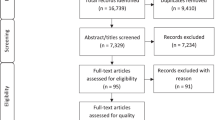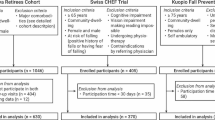Abstract
Falls in geriatry are associated with important morbidity, mortality and high healthcare costs. Because of the large number of variables related to the risk of falling, determining patients at risk is a difficult challenge. The aim of this work was to validate a tool to detect patients with high risk of fall using only bibliographic knowledge. Thirty articles corresponding to 160 studies were used to modelize fall risk. A retrospective case–control cohort including 288 patients (88 ± 7 years) and a prospective cohort including 106 patients (89 ± 6 years) from two geriatric hospitals were used to validate the performances of our model. We identified 26 variables associated with an increased risk of fall. These variables were split into illnesses, medications, and environment. The combination of the three associated scores gives a global fall score. The sensitivity and the specificity were 31.4, 81.6, 38.5, and 90 %, respectively, for the retrospective and the prospective cohort. The performances of the model are similar to results observed with already existing prediction tools using model adjustment to data from numerous cohort studies. This work demonstrates that knowledge from the literature can be synthesized with Bayesian networks.

Similar content being viewed by others
References
Société française de gériatrie et gérontologie/HAS. Recommandations de bonnes pratiques professionnelles: evaluation et prise en charge des personnes âgées faisant des chutes répétées. April 2009. http://www.has-sante.fr/portail/jcms/c_793371/evaluation-et-prise-en-charge-des-personnes-agees-faisant-des-chutes-repetees. (Accessed 26 Jun 2012)
Cumming RG (1998) Epidemiology of medication-related falls and fractures in the elderly. Drugs Aging 12(1):43–53
Formiga F, Navarro M, Duaso E, Chivite D, Ruiz D, Perez-Castejon JM, Lopez-Soto A, Pujol R (2008) Factors associated with hip fracture-related falls among patients with a history of recurrent falling. Bone 43(5):941–944
Daal JO, Van Lieshout JJ (2005) Falls and medications in the elderly. Neth J Med 63(3):91–96
Walker PC, Alrawi A, Mitchell JF, Regal RE, Khanderia U (2005) Medication use as a risk factor for falls among hospitalized elderly patients. Am J Health Syst Pharm 62(23):2495–2499
Kelly KD, Pickett W, Yiannakoulias N, Rowe BH, Schopflocher DP, Svenson L, Voaklander DC (2003) Medication use and falls in community-dwelling older persons. Age Ageing 32(5):503–509
Koski K, Luukinen H, Laippala P, Kivelä SL (1996) Physiological factors and medications as predictors of injurious falls by elderly people: a prospective population-based study. Age Ageing 25(1):29–38
Pariente A, Dartigues JF, Benichou J, Letenneur L, Moore N, Fourrier-Réglat A (2008) Benzodiazepines and injurious falls in community dwelling elders. Drugs Aging 25(1):61–70
Fonad E, Wahlin TB, Winblad B, Emami A, Sandmark H (2008) Falls and fall risk among nursing home residents. J Clin Nurs 17(1):126–134
Baranzini F, Diurni M, Ceccon F, Poloni N, Cazzamalli S, Costantini C, Colli C, Greco L, Callegari C (2009) Fall-related injuries in a nursing home setting: is polypharmacy a risk factor? BMC Health Serv Res 9:228
Scott V, Votova K, Scanlan A, Close J (2007) Multifactorial and functional mobility assessment tools for fall risk among older adults in community, home-support, long-term and acute care settings. Age Ageing 36(2):130–139
Bongue B, Dupré C, Beauchet O, Rossat A, Fantino B, Colvez A (2011) A screening tool with five risk factors was developed for fall-risk prediction in community-dwelling elderly. J Clin Epidemiol 64(10):1152–1160
Demura S, Sato S, Shin S, Uchiyama M. (2011) Setting the criterion for fall risk screening for healthy community-dwelling elderly. Arch Gerontol Geriatr
Edmonson D, Robinson S, Hughes L (2011) Development of the Edmonson psychiatric fall risk assessment tool. J Psychosoc Nurs Ment Health Serv 49(2):29–36
Marschollek M, Rehwald A, Wolf KH, Gietzelt M, Nemitz G, zu Schwabedissen HM, Schulze M et al (2011) Sensors vs experts—a performance comparison of sensor-based fall risk assessment vs conventional assessment in a sample of geriatric patients. BMC Med Inform Decis Mak 11:48
Ensrud KE, Blackwell TL, Mangione CM, Bowman PJ, Whooley MA, Bauer DC, Schwartz AV, Hanlon JT, Nevitt MC, Study of Osteoporotic Fractures Research Group (2002) Central nervous system-active medications and risk for falls in older women. J Am Geriatr Soc 50(10):1629–1637
Zhao D, Weng D (2011) Combining Pubmed knowledge and EHR data to develop a weighted Bayesian network for pancreatic cancer prediction. J Biomed Inform 44(5):859–868
Ben-Gal I (2007) Bayesian networks. In: Ruggeri F, Faltin F, Kenett R (eds) Encyclopedia of Statistics in Quality and Reliability, Wiley, London
Minh N Do (2003) Approximation of Kullback–Leibler distance for dependence trees and Hidden Markov Model. IEEE signal process lett, pp 115–118
Ganz DA, Bao Y, Shekelle PG, Rubenstein LZ (2007) Will my patient fall? JAMA 297(1):77–86
Schwartz AV, Vittinghoff E, Sellmeyer DE, Feingold KR, de Rekeneire N, Strotmeyer ES, Shorr RI, Vinik AI, Odden MC, Park SW, Faulkner KA, Harris TB et al (2008) Diabetes-related complications, glycemic control, and falls in older adults. Diabetes Care 31(3):391–396
Allan LM, Ballard CG, Rowan EN, Kenny RA (2009) Incidence and prediction of falls in dementia: a prospective study in older people. PLoS ONE 4(5):e5521
Darowski A, Chambers SA, Chambers DJ (2009) Antidepressants and falls in the elderly. Drugs Aging 26(5):381–394
Tanaka M, Suemaru K, Ikegawa Y, Tabuchi N, Araki H (2008) Relationship between the risk of falling and drugs in an academic hospital. Yakugaku Zasshi 128(9):1355–1361
French DD, Campbell R, Spehar A, Cunningham F, Bulat T, Luther SL (2006) Drugs and falls in community-dwelling older people: a national veterans study. Clin Ther 28(4):619–630
Woolcott JC, Richardson KJ, Wiens MO, Patel B, Marin J, Khan KM, Marra CA et al (2009) Meta-analysis of the impact of 9 medication classes on falls in elderly persons. Arch Intern Med 169(21):1952–1960
Mets MAJ, Volkerts ER, Olivier B, Verster JC (2010) Effect of hypnotic drugs on body balance and standing steadiness. Sleep Med Rev 14(4):259–267
Vitry AI, Hoile AP, Gilbert AL, Esterman A, Luszcz MA (2010) The risk of falls and fractures associated with persistent use of psychotropic medications in elderly people. Arch Gerontol Geriatr 50(3):e1–e4
Sakai S, Kobayashi K, Nakamura J, Toyabe S, Akazawa K (2007) Accuracy in the diagnostic prediction of acute appendicitis based on the Bayesian network model methods. Inf Med 46:723–726
Burnside ES, Davis J, Chhatwal J, Alagoz O, Linstrom MJ, Geller BM et al (2009) Probabilistic computer model developed from clinical data in national mammography database format to classify mammographic findings. Radiology 251(3):663–672
Gevaert O, De Smet F, Kirk E, Van Calster B, Bourne T, Van Huffel S et al (2006) Predicting the outcome of pregnancies of unknown location: Bayesian networks with expert prior information compared to logistic regression. Hum Reprod 21(7):1824–1831
Sanders DL, Aronsky D (2006) Prospective evaluation of a Bayesian network for detecting asthma exacerbations in a pediatric emergency department. AMIA Symposium, p 1085
Forsberg JA, Eberhardt J, Boland PJ, Wedin R, Healey JH (2011) Estimating survival in patients with operable skeletal metastases: an application of a Bayesian belief network. PLoS ONE 6(5):e19956
Sebastiani P, Nolan VG, Baldwin CT, Abad-Grau MM, Wang L, Adewoye AH et al (2007) A network model to predict the risk of death in sickle cell disease. Blood 110(7):2727–2735
Waterhouse M, Morton A, Mengersen K, Cook D, Playford G (2011) Role of overcrowding in meticillin-resistant Staphylococcus aureus transmission: Bayesian network analysis for a single public hospital. J Hosp Infect 78:92–96
Cuaya G, Munoz-Melendez A, Nunez Carrera L, Morales EF, Quinones I, Perez AI, et al (2012) A dynamic Bayesian network for estimating the risk of falls from real gait data. Med Biol Eng Comput [Epub ahead of print]
Siegelmann HT, Holzman LE (2010) Neuronal integration of dynamic sources: Bayesian learning and Bayesian inference. Chaos 20(3):037112
Naïm P, Wuillemin PH, Leray P, Pourret O, Becker A (2007) In Eyrolles. Réseaux bayésiens. Algorithmes
Oliver D, Papaioannou A, Giangregorio L, Thabane L, Reizgys K, Foster G (2008) A systematic review and meta-analysis of studies using the STRATIFY tool for prediction of fall in hospital patients: how well does it work. Age Ageing 37(6):621–627
Oliver D, Daly F, Martin FC, McMurdo MET (2004) Risk factors and risk assessment tools for falls in hospital in-patients: a systematic review. Age Ageing 33(2):122–130
Schwendimann R, De Geest S, Milisen K (2006) Evaluation of the Morse Fall Scale in hospitalized patients. Age Ageing 35(3):311–313
Webster J, Courtney M, O’Rourke P, Marsh N, Gale C, Abbott B, McRae P, Mason K et al (2008) Should elderly patients be screened for their ‘falls risk’? Validity of the STRATIFY falls screening tool and predictors of falls in a large acute hospital. Age Ageing 37(6):702–706
Milisen K, Staelens N, Schwendimann R, De Paepe L, Verhaeghe J, Braes T, Boonen S, Pelemans W, Kressig RW, Dejaeger E (2007) Fall prediction in inpatients by bedside nurses using the St Thomas’s risk assessment tool in falling elderly inpatients (STRATIFY) instrument: a multicenter study. J Am Geriatr Soc 55(5):725–733
Uusitalo L (2007) Advantages and challenges of Bayesian networks in environmental modelling. Ecol Model 203:312–318
Muir SW, Berg K, Chesworth B, Klar N, Speechley M (2010) Application of a fall screening algorithm stratified fall risk but missed preventive opportunities in community-dwelling older adults: a prospective study. J Geriatr Phys Ther 33(4):165–172
Acknowledgments
LL conducted the literature search, designed the network, performed the statistical analyses, and wrote the manuscript. LB helped with the analyses and the writing. CC supervised the data collection. MD had the idea for the study, supervised the study, co-supervised the analyses, and helped for the writing. All authors read and approved the final version of the manuscript.
Conflict of interest
None.
Author information
Authors and Affiliations
Corresponding author
Rights and permissions
About this article
Cite this article
Lalande, L., Bourguignon, L., Carlier, C. et al. Bayesian networks: a new method for the modeling of bibliographic knowledge. Med Biol Eng Comput 51, 657–664 (2013). https://doi.org/10.1007/s11517-013-1035-8
Received:
Accepted:
Published:
Issue Date:
DOI: https://doi.org/10.1007/s11517-013-1035-8




